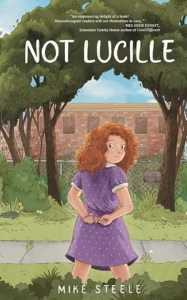Not Lucille
Mike Steele
Creative James Media
Published June 24, 2025
Amazon | Bookshop | Goodreads
About Not Lucille
It’s 1931, and children should be seen and not heard.
Ten-year-old Lucy Contento can’t help but be seen and heard. And she’s always in trouble for it. She talks too much. She’s impulsive. She writes with the wrong hand. Her parents would be mad enough knowing she routinely earns afterschool detentions. They’d be furious if they found out she’s been sneaking onto the campus of the nearby Trenton Academy for the Deaf. But there, Lucy has met Florence, a lonely and profoundly deaf girl her own age. Florence doesn’t mind Lucy’s flaws. Though Florence can’t speak, she has a unique way of communicating. If Lucy can figure out how to learn Florence’s special language, the two could be friends.
Lucy devises a plan, but it’s going to cost a whopping seven dollars and ninety-eight cents—more money than she’s got. She can’t tell her parents why she wants the funds without revealing she’s been visiting Florence. Besides, her parents don’t have a penny to spare. Her father has been out of work for months. And nobody else in the Contento family has an income. Or do they? Lucy soon discovers she’s not the only member of her family hiding something. Can she get the money she needs while keeping everyone’s secrets? Or will her scheming land her in the biggest trouble of her life?
In this story of friendship and belonging, a young girl navigates prejudice, punishment, and identity while establishing her voice in a world that often tries to keep her silent.
My Review
This story has a hint of the A Tree Grows in Brooklyn vibe to it. The time period, the northeast city setting, the scenes showing Lucy in class, and some of the dynamics in her family all made me think of that story (though the books don’t serve the same audience).
I like that this is historical story includes neurodivergent and disabled characters. Lucy experiences symptopms that today would prompt her to be screened for ASD/ADHD. Her friend Florence is Deaf. The story draws readers into a moment in history when Irish and Italian immigrants faced steep discrimination– a reality that my own family faced in those days.
The story is well-suited to middle grade readers, crafting scenes that show what life was like without slowing down the story or getting lost in the details. It sounds from the author’s note that Steele has his own family history that connects to the story (namely his grandmother Lucy and her experiences) and that he made sure to include sensitivity readers who could evaluate the scenes that include Deaf representation.
Through her experiences, Lucy learns new ways to communicate and how to appreciate the differences between herself and others. She learns that sometimes people we think we know and don’t like can surprise us. I liked the way that some of the other characters in the story surprised Lucy.
Young readers interested in the early 1930s in America will find this an informative, enjoyable story. The short chapters make this a quick, engaging read. The author’s note in the back of the book also offers some context for elements of the story, which helps explain why, for instance, Florence wasn’t allowed to use sign language at school.
Content Notes
Recommended for Ages 8 to 12.
Profanity/Crude Language Content
None.
Romance/Sexual Content
None.
Spiritual Content
None.
Violent Content
Early in the story, Lucy refers to the students at a school for the Deaf by a name that she later realizes is derogatory. She stops using the term. A boy picks on her in the halls at school. Her father faces discrimination as an Italian immigrant and struggles to find work. The story also references illegal gambling activity.
Drug Content
None.
Note: This post contains affiliate links, which do not cost you anything to use but help support this blog. I received a free copy of this book in exchange for my honest review. All opinions are my own.
